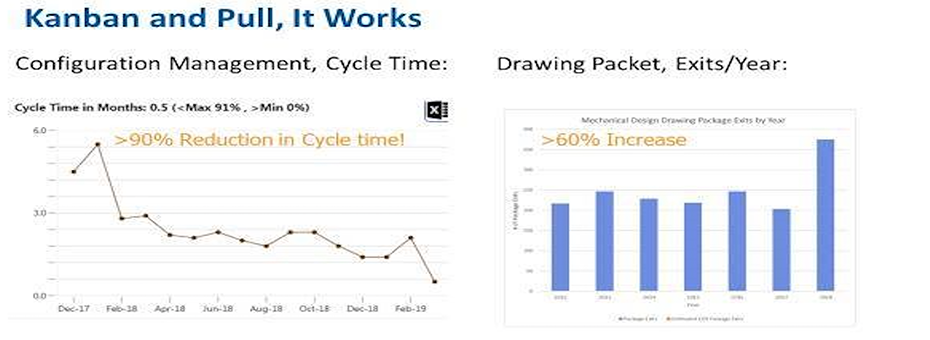After successfully implementing lean principles in manufacturing, Solar Turbines took them to product development processes, reducing firefighting and boosting development velocity. LEI’s Chet Marchwinski recently talked about the effort with Solar Products Manager Howard Kinkade.
Q: What was the business problem Solar Turbines was addressing with lean product and process development (LPPD) principles?
Howard: Like many organizations, our lean journey started in manufacturing. A little over 10 years ago, I was working in the product development group under a new director. He had recognized that our new product introduction process was excellent and produced great results, but every once in a while, it fell short in some areas, maybe with schedule, maybe with some of our expenditures, cost management, things of that nature. “We applied these tools to the next engine enhancement program and it accelerated from two years to 17-to-18 months.”
He asked, “Do we want to continue to expand our NPI book and make it any thicker?” We found as the book got thicker, performance didn’t necessarily improve. He read Lean Product and Process Development. He also read The Toyota Product Development System. Of course, I had homework. I had to do the same reading.
We then reflected and asked ourselves, “Do we want to experiment with this?” I certainly said, “Yes.” It was pretty exciting for me. Our initial focus was on velocity. It was pretty simple. We didn’t take too big of a bite. We focused on velocity.
We connected value-stream mapping of recent development programs and started applying tools like obeya and front-loading. The simple applications of those tools yielded great results. (See charts above -Ed.) For example, our typical engine enhancement program might be two years from development to test. We applied these tools to the next engine enhancement program and it accelerated from two years to 17-to-18 months.
Q: One of the most successful experiments was in workflow management to level the work and improve the value-stream flow. What did the team do? What were those results?
Howard: We had been on the journey for probably about eight, 10 years and something kept coming up in all of our workshops. We had problems with our workflow management. It showed up in value-stream maps — and I think many of the people out there have played with this — it showed up as waiting. Our flows weren’t synchronized.
We borrowed from a trick that manufacturing uses called kanban — a pull system. We identified that in order for us to get better and enable more lean activities, we needed to get our workflow management under control. We applied kanban in a pull system to the workplace. Great results so far.
Q: Can you tell us about an experiment that didn’t go so well and, more importantly, what you learned?
Howard: Well, most experiments, if not all of them, have been wildly successful, but there’s always something we learn. I can think of one right now that we struggled with a long time. In our workflow management system — and I always ask this question — if you prioritize half the work, how much work have you prioritized? Some people say none of it, and that’s what I used to say. Someone gave me a witty answer once and said, “You’ve prioritized half of it, but the lower half.”
Our goal was to create a prioritization system where we didn’t prioritize part of the work. We prioritized all the work. It didn’t matter what it was; we’d be able to prioritize across the different types of work. Our prioritization system had to be quite extensive to deal with lots of different business needs.
We kept finding that one problem was our training. When we put training efforts into the prioritization system, they were always at the bottom. We kept playing with the algorithm, but every time we changed the algorithm, we’d create some other problems.
Then we finally took a step back and said, “We’re doing training wrong. We know training is healthy for business, and we need to invest in it. Let’s determine what percentage of our investment should always go to training.”
We set aside a training bucket, and we allow each of the managers to spend that portion of it that’s theirs to develop their tools, processes, and people. They can go ahead and create cards for training and pull the amount as long as they don’t exceed the budget. This allows them to manage the development of their people, and it solved one of our biggest problems in prioritization.
Q: You’re working with lean product and process development. Has it changed behaviors in the ways people manage and lead?
Howard: You can mechanistically use lean tools and get results. But I found after three or four years, a lot of these process improvements disappeared. We realized that we didn’t have the cultural values, behaviors, and thinking to sustain the gains.
The real “aha” moment was: It’s not the tools. We always say that. Everyone says that. It’s not the tools, but sometimes you have to use the tools to go on the learning journey. In the last couple years in gas compressor engineering, a new director decided that he wanted to focus on the culture. He works on what are the behaviors, the values, and the cultural statement that we want to lead by. This focus on cultural values and behaviors has now enabled the tools to be more successful. I would say the tools help with the learning, but they don’t change your culture. Your culture needs to change and then the tools become highly effective.





